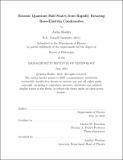Bosonic Quantum Hall States from Rapidly Rotating Bose-Einstein Condensates
Author(s)
Shaffer, Airlia
DownloadThesis PDF (16.29Mb)
Advisor
Zwierlein, Martin W.
Terms of use
Metadata
Show full item recordAbstract
Rotating Bose-Einstein condensates (BECs) were explored as a platform for studying quantum Hall physics. This work relies on the equivalence between neutral particles under rotation and charged particles in a magnetic field to create rotational analogs of quantum Hall states of bosons.
A novel geometric squeezing protocol is presented for creating states with arbitrary, controllable Landau level occupation. Lowest Landau level (LLL) Landau gauge condensates are observed for the first time using this method enabled by $\textit{in situ}$ imaging.
In the flat bands created through rotation, interaction energy dominates kinetic energy facilitating the study of the interaction driven dynamics of Landau gauge quantum Hall states of bosons. These states crystallize into a periodic array of superfluid droplets, at a rate that demonstrates the onset of dynamics in the LLL. In addition, the random phase of the superfluid array upon separate iterations of the experiment suggests that this state shares some properties with a supersolid.
For moderate rotation frequencies, where there are not distinct flat bands, the hydrodynamic instability of the condensate to a patterned density distribution is observed. Microscopically, the instability to pattern formation results from the synthetic magnetic field induced minimum in the collective excitation spectrum crossing zero. The depth and position of this minimum is controlled through rotation and so too are the emergent pattern anatomies. Density depleted regions of the condensate are full of quantized vortices, which enter the cloud causing it to turbulently evolve into a vortex liquid.
Date issued
2023-06Department
Massachusetts Institute of Technology. Department of PhysicsPublisher
Massachusetts Institute of Technology